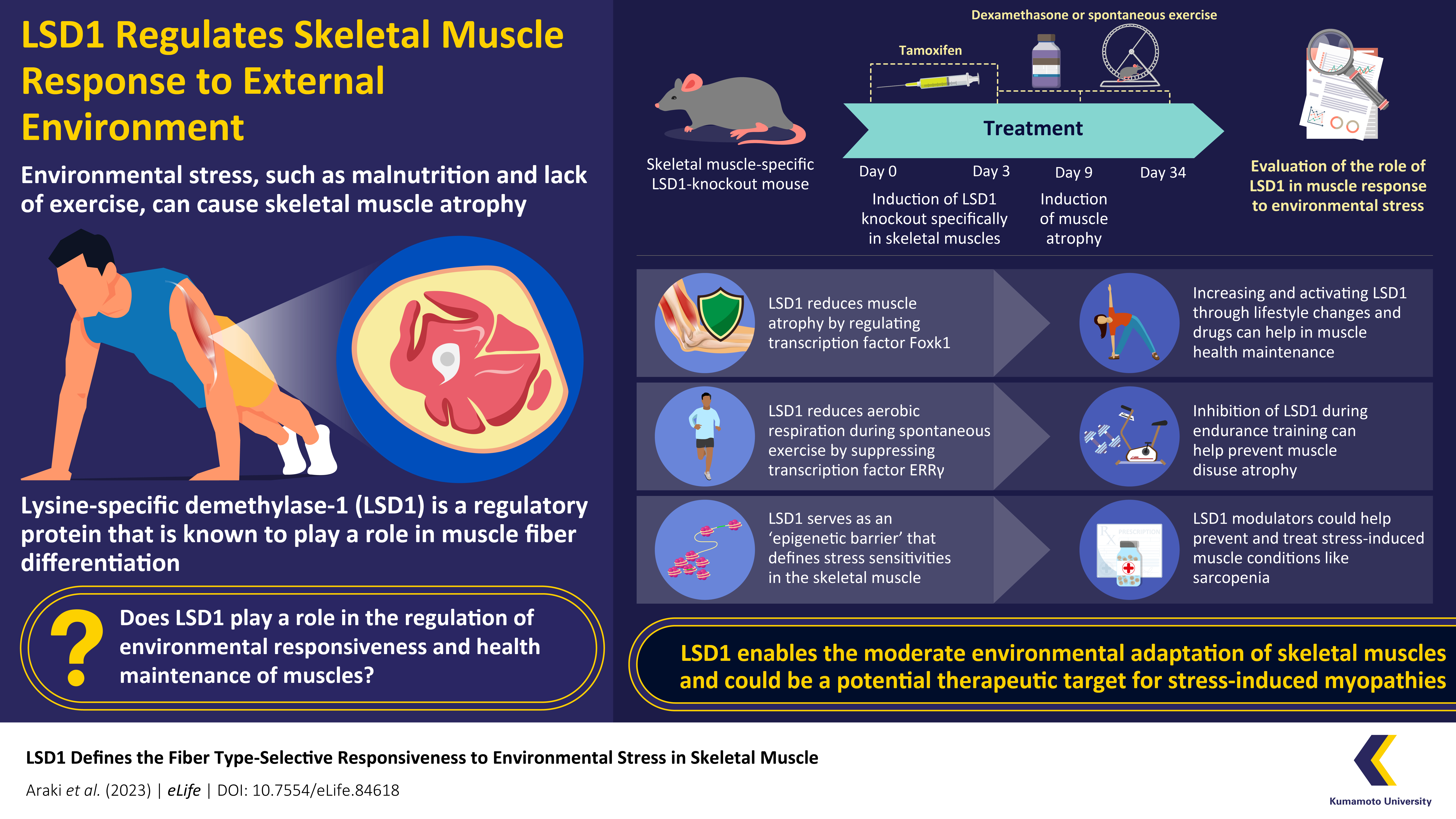Understanding how Excessive Adaptation of Muscles to Environmental Conditions is Suppressed

LSD1, a gene expression regulatory protein, moderates the response of skeletal muscle to environmental stress
Muscle strength and development is regulated by various environmental factors, such as exercise and diet. However, the underlying mechanism of gene function regulation is not well understood. A team of researchers from Japan now reveal that the enzyme lysine-specific demethylase 1 (LSD1), which is involved in gene expression, regulates muscle sensitivity to environmental stress. Their study elucidates a part of the environmental adaptation mechanism of muscles.
Muscles, particularly skeletal muscles, play an essential role in the motor function and homeostasis of the whole body. The muscle mass enlarges and shrinks depending on environmental factors, such as aging, nutrition, and exercise. However, this phenomenon, known as environmental adaptation, can be detrimental in conditions of high stress as it induces over-adaptation, leading to pathological conditions. High stress situations causing skeletal muscle atrophy (or reduction in muscle mass) due to environmental stress include malnutrition or lack of exercise, resulting in low physical ability. It is possible to maintain muscle function through lifestyle habits, such as adequate nutritional intake and exercise. Understanding this phenomenon at a molecular level will help improve life expectancy and reduce the burden of nursing care.
Genes have various “markers” attached to them, which regulate gene activation and expression. These markers are chemical modifications (methyl groups, acetyl groups, etc.) on the DNA molecule and associated histone proteins, forming what we call the “epigenome”. Since the epigenome can be altered by environmental stress, it is believed to play an important role in environmental adaptation. However, epigenomic control mechanisms involved in muscle sensitivity to environmental stress are poorly understood.
In this regard, Hiroki Araki from Kumamoto University, along with Shinjiro Hino, Mitsuyoshi Nakao, and other colleagues, have revealed that LSD1 is involved in the regulation of muscle environmental responsiveness and health maintenance. The group had previously elucidated the function of the LSD1 enzyme in epigenetic marking. While it was known that LSD1 is activated in the fast-twitch muscle fiber type and may be involved in maintaining muscle health, the specific details were unknown.
Explaining the experiments carried out, Prof. Nakao says, “We created mutant mice with LSD1 knocked out specifically in skeletal muscles and examined their responsiveness to environmental stimuli.” When dexamethasone, a drug that induces atrophy and weakness of the outer muscles, was given to these ‘LSD1-mKO’ mice, they showed much more severe symptoms than when it was administered to wild-type mice. Thus, loss of LSD1 causes increased muscle atrophy. An inactivation of transcription repressor Foxk1, which normally cooperates with LSD1, was found to be one of the main reasons behind the exacerbation of symptoms.
In addition, long-term locomotor training in mice has been shown to improve endurance and posture, as the inner muscles involved in maintenance increase in size. Interestingly, LSD1 deficiency was found to enhance these effects. In LSD1-mKO mice, the expression level of the transcription factor ERRγ, which activates aerobic respiration, was markedly increased, which in turn improved the effect of exercise. These results suggest that lack of LSD1 causes muscle to overreact to environmental stress.
Thus, LSD1 allows muscles to moderately respond to environmental stress. From a medical perspective, relaxing this response can have several important implications, as it might allow skeletal muscles to adapt to the environment appropriately. Sarcopenia, a disease wherein the outer muscle mass and muscle strength decreases, significantly reduces the quality of life among older adults. In mice and humans, expression of LSD1 in muscles decreased with age, and the expression of muscle atrophy genes increases. It is possible to activate LSD1 and increase its expression through lifestyle habits and medication, which may lead to the maintenance of muscle health.
In contrast, suppressing LSD1 function during training may be beneficial for the prevention and management of disuse atrophy (muscle weakness caused by prolonged disuse of muscles). Elaborating on the implications of the study, Prof. Nakao says “The study has important implications from a medical perspective. Controlling LSD1 function according to life stage and living environment may provide a new strategy for health longevity.”
About Prof. Mitsuyoshi Nakao
Mitsuyoshi Nakao is a Professor at the Department of Medical Cell Biology, Institute of Molecular Embryology and Genetics, Kumamoto University, Japan. He has written several research papers and books on epigenetics, which is the major focus of his work. Through his research, he aims to explore how living systems are programmed and how this knowledge can be applied to future medicine. He is also the Secretary of the Japanese Society for Epigenetics.
[Funding]
- Japan Society for the Promotion of Science (20H04108, 21K19513, 21H02686, and 20KK0185)
- Japan Agency for Medical Research and Development (21gk0210029h0101)
- Takeda Science Foundation
- Nakatomi Foundation
- Center for Metabolic Regulation of Healthy Aging, Kumamoto University
- Program of the Inter-University Research Network for High Depth Omics, IMEG, Kumamoto University


